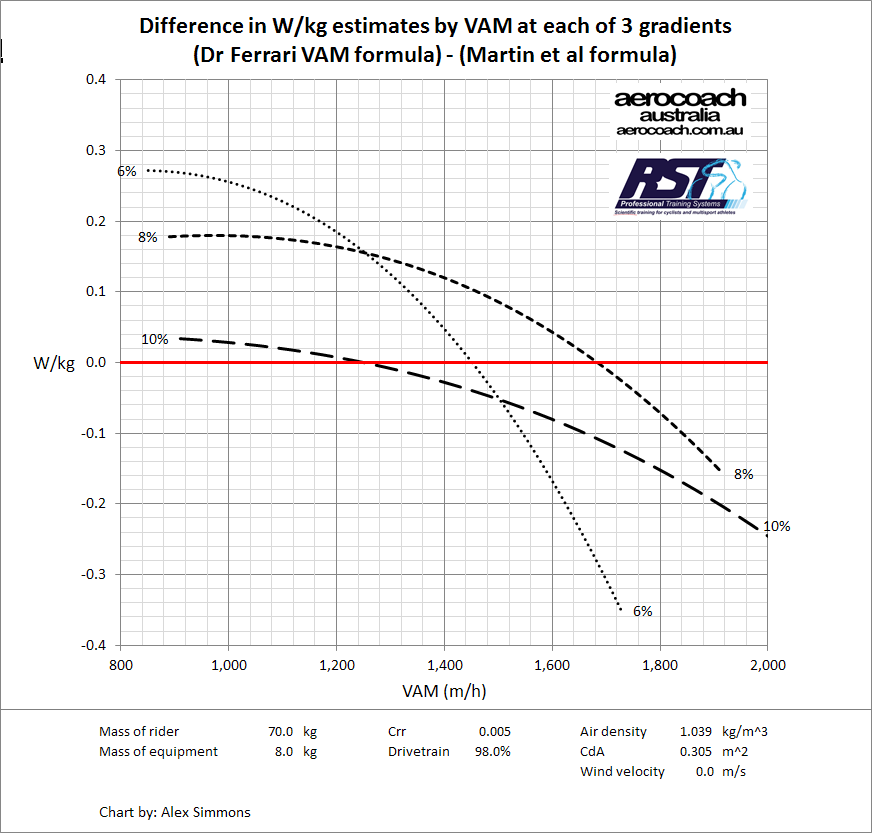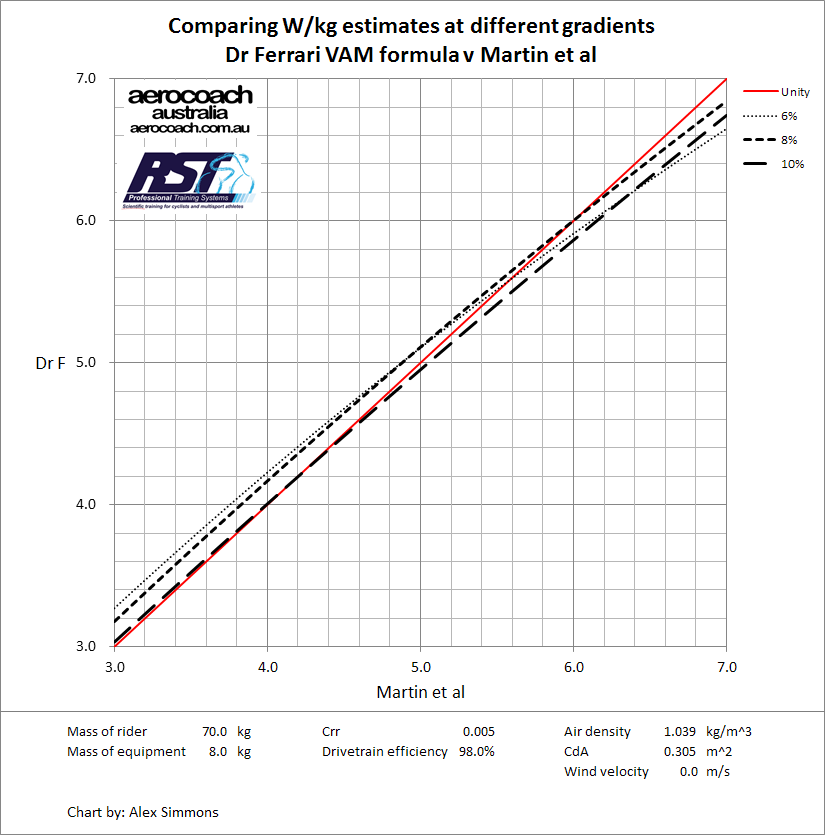- Mar 10, 2009
- 2,973
- 5
- 11,485
Alex Simmons/RST said:5.4 W/kg is the Clinic's new 6.4 W/kg.
Merckx index said:Alex Simmons/RST said:5.4 W/kg is the Clinic's new 6.4 W/kg.
We're not talking about a 30 minute climb to a finish, where the rider goes all out. We're talking about an hour climb, saving enough energy to ride 70-75 more km, including another climb at 5.4 W/kg.
Durden93 said:That’s not what we’re talking about either. There was a lot of descending after the Finestre. Obviously Froome did a tremendous ride on the descents to grow his gap but descending is much more about technical prowess than physical effort. The effort becomes a lot more normal when you consider that Froome’s effort on the descents was probably in the 3-4w/kg range, which is a tempo effort. For comparison’s sake, Barguil was at 6w/kg for 1 hour over 3 climbs in last year’s tdf. That’s not to say that Barguil’s performance was clean, but that Froome’s isn’t unprecedented.
Alex Simmons/RST said:What's Froome's threshold? Let's say 6.0 W/kg. It's probably higher but let's say 6.
5.4 is 90% of threshold. Less if we think his threshold is higher. 2 hours of that with a decent amount of endurance effort in the middle doesn't strike me as wildly strange. 90% of threshold is sustainable for quite a long time.
All the data says to me is it's well inside the bit fat fuzzy line demarcating the plausible/non-plausible zone and there's not a lot we can infer from it, per se.
Yes I was being deliberately conservative.Durden93 said:Alex Simmons/RST said:What's Froome's threshold? Let's say 6.0 W/kg. It's probably higher but let's say 6.
5.4 is 90% of threshold. Less if we think his threshold is higher. 2 hours of that with a decent amount of endurance effort in the middle doesn't strike me as wildly strange. 90% of threshold is sustainable for quite a long time.
All the data says to me is it's well inside the bit fat fuzzy line demarcating the plausible/non-plausible zone and there's not a lot we can infer from it, per se.
I’d say Froome’s threshold is around 6.2/6.3. But in the third week of a GT it’s still lower. Pinot’s data showed that he can hold 5w/kg for 5 hours so 5.4 for two hours for Froome isn’t too surprising.
Alex Simmons/RST said:Yes I was being deliberately conservative.Durden93 said:Alex Simmons/RST said:What's Froome's threshold? Let's say 6.0 W/kg. It's probably higher but let's say 6.
5.4 is 90% of threshold. Less if we think his threshold is higher. 2 hours of that with a decent amount of endurance effort in the middle doesn't strike me as wildly strange. 90% of threshold is sustainable for quite a long time.
All the data says to me is it's well inside the bit fat fuzzy line demarcating the plausible/non-plausible zone and there's not a lot we can infer from it, per se.
I’d say Froome’s threshold is around 6.2/6.3. But in the third week of a GT it’s still lower. Pinot’s data showed that he can hold 5w/kg for 5 hours so 5.4 for two hours for Froome isn’t too surprising.
In his physiological testing post TdF he was 6.0 W/kg (at test weight, not race weight) with BL sustained at 4mmol/l.
Add 0.25 W/kg if you pare back to race weight. Not all that long after a grand tour.
4 mmol/l is probably under his real sustainable BL level at threshold, so I'd expect a fresh race weight Froome's threshold to be at least 6.25 W/kg and quite possibly higher (average BL at threshold for trained cyclists is closer to 7mmol/l but there is large individual variance).
Durden93 said:I’d say Froome’s threshold is around 6.2/6.3. But in the third week of a GT it’s still lower. Pinot’s data showed that he can hold 5w/kg for 5 hours so 5.4 for two hours for Froome isn’t too surprising.
Alex Simmons/RST said:In his physiological testing post TdF he was 6.0 W/kg (at test weight, not race weight) with BL sustained at 4mmol/l.
Add 0.25 W/kg if you pare back to race weight. Not all that long after a grand tour.
4 mmol/l is probably under his real sustainable BL level at threshold, so I'd expect a fresh race weight Froome's threshold to be at least 6.25 W/kg and quite possibly higher (average BL at threshold for trained cyclists is closer to 7mmol/l but there is large individual variance).
Netserk said:Not counting the time he descended, he did 5.24 W/kg for the last 2 hours of the stage.
The nature of it is that everything he did today is within the realms of physiological capacity. It was the style with which he did it, the panache and the bravado and the courage [which stood out].
Netserk said:I used 69.5kg as his weight, as that corresponds with what was used to calculate his W/kg on the climbs - but indeed after looking at it closer, the paper states his weight was between 68kg and 66.3kg. A bit weird then to use 69.5kg...
The correct weight should be the 67.15kg that is listed in the calculations, even if it wasn't the one used.
edit: This was a response to a post by Merckx index.
Interesting.Alex Simmons/RST said:Velon reported that Froome's Finestre attack lasted 11 minutes and averaged 397W. At (say) 67.5kg that's 11-min @ ~5.9W/kg.
https://www.velon.cc/en/news/2018/05/why-397-is-chris-froome-s-winning-giro-d-italia-number
As for the Swart data, there is quiet a difference in physiological responses between 20-min power and 40-min power. 40-min and 60-min power and power at threshold will probably not be all that different as the P-D curve is much much flatter there, but 20-min power may well be quite different as non-sustainable physiological responses to the energy demand are playing a more substantial role. 20-min power is definitely above threshold power.
That said, doping/not doping? Low numbers are not indicative of not doping. But lower numbers don't generate click bait "doper" headlines for the usual suspects. It doesn't fit their narrative.



Netserk said:Not counting the time he descended, he did 5.42 W/kg for the last 2 hours of the stage.
*edited the W/kg so it is based on a weight of 67.15kg instead of 69.5kg.
Netserk said:There wasn't much false flat in the stage to Morzine.
Merckx index said:silvergrenade said:More Strides than Rides said:Would love to see numbers from today
Stage 19. MTF Jafferau (7.25 km, 9.02 %, 654 m)
24:39 | Carapaz
24:46 | Pinot
24:51 | M.A.Lopez
25:02 | Dumoulin
25:03 | Froome
Today's fastest time (Carapaz) is 2:55 slower than record time 21:44 (Santambrogio/Nibali in 2014
Stage 19
Colle delle Finestre (18.40 km, 9.21 %, 1694 m)
Record time: Jose Rujano 1:02:16 (2011)
Froome climbed Finestre in 1:04:18.
Credit: https://twitter.com/ammattipyoraily
Thanks for these data. Both of Froome's times on the climbs correspond to 5.40 W/kg by Ferrari's equation, well below the level considered more or less the limit of clean riding. Of course, most of the Finestre was climbed with the group; he would have been putting out more power after he attacked. And assuming he put out the same power on Sestriere, he was sustaining that level for about two hours of climbing, punctuated by what? 30-40 minutes of descending?
In his published data, Pinot recorded just 5.0 W/kg for 2 hours in 2013:
http://www.fredericgrappe.com/wp-content/uploads/2015/03/pinot-ppr.pdf
Pretty sure they've got the friction wrong on Finistere. But yeah, there's no humid sterrato option on the simulators. I'd add a little to that part of it, I don't know if I'd trust the Velon numbers given the glitches but I'd trust them more than 5.1W/Kg. It takes a little more power than that run that type of winnowing machine at a WorldTour level.miguelindurain111 said:Merckx index said:silvergrenade said:More Strides than Rides said:Would love to see numbers from today
Stage 19. MTF Jafferau (7.25 km, 9.02 %, 654 m)
24:39 | Carapaz
24:46 | Pinot
24:51 | M.A.Lopez
25:02 | Dumoulin
25:03 | Froome
Today's fastest time (Carapaz) is 2:55 slower than record time 21:44 (Santambrogio/Nibali in 2014
Stage 19
Colle delle Finestre (18.40 km, 9.21 %, 1694 m)
Record time: Jose Rujano 1:02:16 (2011)
Froome climbed Finestre in 1:04:18.
Credit: https://twitter.com/ammattipyoraily
Thanks for these data. Both of Froome's times on the climbs correspond to 5.40 W/kg by Ferrari's equation, well below the level considered more or less the limit of clean riding. Of course, most of the Finestre was climbed with the group; he would have been putting out more power after he attacked. And assuming he put out the same power on Sestriere, he was sustaining that level for about two hours of climbing, punctuated by what? 30-40 minutes of descending?
In his published data, Pinot recorded just 5.0 W/kg for 2 hours in 2013:
http://www.fredericgrappe.com/wp-content/uploads/2015/03/pinot-ppr.pdf
According to French pseudoscientists Froome's numbers on his legendary clean break were
- Finestre 64 min at 5.14 W/kg (including 28 min at 5.57 W/kg)
- Sestrieres 21 min at 5.29 W/kg
- Jaffereau 25 min at 5.43 W/kg
https://mobile.twitter.com/lapreuvepar21/status/1001165650210025473
Alex Simmons/RST said:5.4 W/kg is the Clinic's new 6.4 W/kg.
On this calculator, just the difference between riding on an asphalt road and on rough tarmac implies a doubling of the Crr:Alex Simmons/RST said:In terms of sensitivity of rolling resistance to W/kg estimates, even a doubling of a typical road Crr assumption would add ~0.2W/kg or an error in W/kg estimation of about 3%. That's on say a 10% climb.





